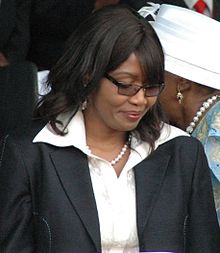Women in Namibia
 | |
| General Statistics | |
|---|---|
| Maternal mortality (per 100,000) | 195 (2017) |
| Women in parliament | 44.2% (2021) |
| Women over 25 with secondary education | 39.9% |
| Women in labour force | 58.5% (2017) |
| Gender Inequality Index[1] | |
| Value | 0.445 (2021) |
| Rank | 111st out of 191 |
| Global Gender Gap Index[2] | |
| Value | 0.807 (2022) |
| Rank | 8th out of 146 |
Women in Namibia face challenges in their health, gender based violence, and access to education. The government of Namibia is taking steps to provide women with equal rights to a degree that is largely unparalleled in Sub-Saharan Africa, including the promise of gender equality and increased parliament representation in the Namibian constitution.[3][4] Women currently serve in nearly half of all seats in parliament and the first female Prime Minister was elected in 2015.[5]
Health
[edit]HIV/AIDS is largely prevalent within Namibia. HIV-related deaths reached its peak in 2004, when 12,000 people died, but has since declined to around 2,900 deaths in 2021.[6]
The socioeconomic status of women remains a significant indicator of HIV status.[7] Of the poorest women in Namibia, the HIV prevalence rate is at 21.4%, compared to the richest households with an HIV prevalence rate of 3.7%.[7]
Large strides have been made in the last decade to decrease the rate of maternal mortality in Namibia. In 2017, maternal mortality was at a rate of 195 deaths per 100,000 live births, down from 358 deaths per 100,000 live births in 2004.[8] Life expectancy of women in Namibia has also improved. In 2020, the female life expectancy was 67 years, a large gap from 53 years in 2004.[9]
Domestic violence
[edit]The nation's 1990 constitution guarantees women equal protection under law and prohibits gender discrimination.[10][11] Although unprecedented for its time, there is much to be done to close the gender gap between men and women in Namibia.
Domestic violence remains a large concern in Namibia. On average 26.7% of Namibian women between ages 15–49 have experienced domestic and/or sexual violence at least once, with 52% of these women aged 15–19.[12]
Namibia outlawed marital rape in 2000.[13]
Legal rights and parliamentary representation
[edit]The nation's 1990 constitution guarantees women equal protection under law and prohibits gender discrimination.[14][15]

Within the past decade, Namibia has seen increased pushes for the representation of women in parliament. In 2004, women constituted 29% of all parliament members, placing Namibia at seventeenth in the world for female representation in parliament.[16] In 2014, the South West Africa People's Organisation introduced a policy committing to filling half of its seats in parliament with women, in addition to a "zebra" system in which a male prime minister would have a female deputy minister and vice versa.[4] As of 2021, 44% of the Namibian parliament has seats filled by women.[5]
In March 2015, Saara Kuugongelwa was appointed as Prime Minister of Namibia, making her the first woman to serve as Namibian Prime Minister.[17]
References
[edit]- ^ "Human Development Report 2021/2022" (PDF). HUMAN DEVELOPMENT REPORTS. Retrieved 19 December 2022.
- ^ "Global Gender Gap Report 2022" (PDF). World Economic Forum. Retrieved 9 February 2023.
- ^ "Namibia". UN Women. Retrieved 2019-02-24.
- ^ a b O'Riordan, Alexander; Service, from the South African Civil Society Information; AllAfrica.com, through; network, part of the Guardian development (2014-07-08). "Namibia's 'zebra' politics could make it stand out from the global herd | Alexander O'Riordan". The Guardian. ISSN 0261-3077. Retrieved 2019-02-24.
- ^ a b "Country Fact Sheet | UN Women Data Hub". data.unwomen.org. Retrieved 2023-02-06.
- ^ "Namibia". www.unaids.org. Retrieved 2023-01-21.
- ^ a b Ekholuenetale, Michael; Onuoha, Herbert; Ekholuenetale, Charity Ehimwenma; Barrow, Amadou; Nzoputam, Chimezie Igwegbe (2021). "Socioeconomic Inequalities in Human Immunodeficiency Virus (HIV) Sero-Prevalence among Women in Namibia: Further Analysis of Population-Based Data". International Journal of Environmental Research and Public Health. 18 (17): 9397. doi:10.3390/ijerph18179397. ISSN 1660-4601. PMC 8431544. PMID 34501987.
- ^ "Maternal mortality ratio (modeled estimate, per 100,000 live births) - Namibia | Data". data.worldbank.org. Retrieved 2023-02-06.
- ^ "Life expectancy at birth, female (years) - Namibia | Data". data.worldbank.org. Retrieved 2023-02-06.
- ^ "Women's Property Rights In Namibia: An Investigative Report to Determine The Potential for Litigation" (PDF). University of Wyoming Human Rights Clinic. January 2015.
- ^ "| Human Development Reports". hdr.undp.org. Retrieved 2019-02-24.
- ^ "Proportion of ever-partnered women and girls aged 15-49 years subjected to physical and/or sexual violence by a current or former intimate partner in the previous 12 months". www.who.int. Retrieved 2023-02-06.
- ^ "Refworld | Namibia: Domestic violence, including state protection, services and recourse available to victims". Unhcr.org. Retrieved 2013-08-17.
- ^ "Women's Property Rights In Namibia: An Investigative Report to Determine The Potential for Litigation" (PDF). University of Wyoming Human Rights Clinic. January 2015.
- ^ "| Human Development Reports". hdr.undp.org. Retrieved 2019-02-24.
- ^ Bauer, Gretchen (2004). "'The Hand That Stirs the Pot Can Also Run the Country': Electing Women to Parliament in Namibia". The Journal of Modern African Studies. 42 (4): 479–509. doi:10.1017/S0022278X04000370. ISSN 0022-278X. JSTOR 3876136. S2CID 154703040.
- ^ "Saara Kuugongelwa-Amadhila". Council of Women World Leaders. Retrieved 2023-01-21.
